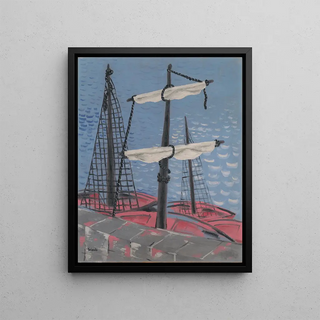Art print | Fishing boats - Mikuláš Galanda


View from behind

Frame (optional)
Art print Bateaux de pêche - Mikuláš Galanda – Engaging introduction
In the vast panorama of modern art, certain works stand out for their ability to capture the very essence of everyday life. "Bateaux de pêche - Mikuláš Galanda" is one such creation that, through its apparent simplicity, evokes deep emotions. This piece, depicting boats peacefully floating on calm waters, invites us into meditative contemplation. The nuances of color and the play of light on the water's surface transport us to a world where time seems suspended, where each brushstroke tells a story. The scene, both familiar and timeless, reminds us of the fragile harmony between man and nature, a theme dear to the artist.
Style and uniqueness of the work
Mikuláš Galanda, through "Bateaux de pêche," employs a style that combines realism with a touch of poetic abstraction. The shapes of the boats, while recognizable, are treated with a freedom that gives them an almost dreamlike dimension. The colors, carefully chosen, intertwine to create a serene atmosphere, where the blue of the water blends with the earthy tones of the vessels. This chromatic dialogue, enriched by touches of light, brings the canvas to life, making it vibrant and dynamic. Galanda thus manages to transcend the mundane subject to create an art print that resonates with emotional depth. The composition, balanced and harmonious, invites us to delve into this scene and explore its subtleties, to discover the hidden stories behind each boat.
The artist and his influence
Mikuláš Galanda, an emblematic figure of 20th-century Slovak art, knew how to mark his era with an innovative and personal approach. Influenced by the artistic currents of his time, he integrated elements of post-impressionism while developing a style unique to himself. His work reflects a constant quest for beauty and a search for truth in everyday life. Galanda is interested in human nature and its interaction with the world around him, and "Bateaux de pêche" is a perfect illustration of this exploration. Through his

Matte finish

View from behind

Frame (optional)
Art print Bateaux de pêche - Mikuláš Galanda – Engaging introduction
In the vast panorama of modern art, certain works stand out for their ability to capture the very essence of everyday life. "Bateaux de pêche - Mikuláš Galanda" is one such creation that, through its apparent simplicity, evokes deep emotions. This piece, depicting boats peacefully floating on calm waters, invites us into meditative contemplation. The nuances of color and the play of light on the water's surface transport us to a world where time seems suspended, where each brushstroke tells a story. The scene, both familiar and timeless, reminds us of the fragile harmony between man and nature, a theme dear to the artist.
Style and uniqueness of the work
Mikuláš Galanda, through "Bateaux de pêche," employs a style that combines realism with a touch of poetic abstraction. The shapes of the boats, while recognizable, are treated with a freedom that gives them an almost dreamlike dimension. The colors, carefully chosen, intertwine to create a serene atmosphere, where the blue of the water blends with the earthy tones of the vessels. This chromatic dialogue, enriched by touches of light, brings the canvas to life, making it vibrant and dynamic. Galanda thus manages to transcend the mundane subject to create an art print that resonates with emotional depth. The composition, balanced and harmonious, invites us to delve into this scene and explore its subtleties, to discover the hidden stories behind each boat.
The artist and his influence
Mikuláš Galanda, an emblematic figure of 20th-century Slovak art, knew how to mark his era with an innovative and personal approach. Influenced by the artistic currents of his time, he integrated elements of post-impressionism while developing a style unique to himself. His work reflects a constant quest for beauty and a search for truth in everyday life. Galanda is interested in human nature and its interaction with the world around him, and "Bateaux de pêche" is a perfect illustration of this exploration. Through his









